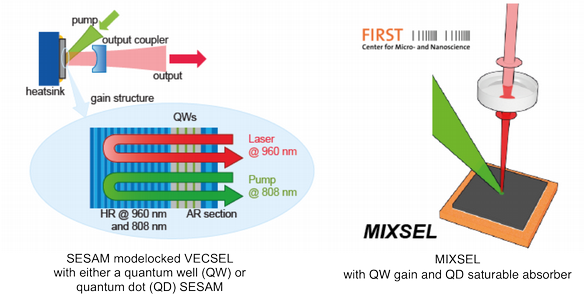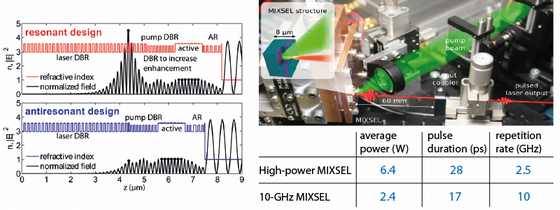MIXSEL
The development of the modelocked integrated external-cavity surface emitting laser (MIXSEL) at ETH Zürich is a consequent step to further simplify SESAM-modelocked VECSELs by vertical integration of the saturable absorber into the semiconductor structure. This enables stable mode-locking in simple straight cavities that allow pulse repetition rates of several tenth of GHz. The MIXSEL principle allows for low-cost wafer-scale production and quasi-monolithic designs, which results in simple and low-cost high-power mode-locked lasers.
Usually cavities with small spot sizes on standard quantum-well based SESAMSs are used in order to achieve stable-modelocking Download Ref. [248] (PDF, 1.4 MB). For the integration low saturation fluence quantum-dot absorbers are employed for modelocking with the same spot-sizes on the gain and absorber section (1:1 modelocking).
The MIXSEL structures are grown in the FIRST cleanroom facility at ETH Zürich by molecular beam epitaxy (MBE). In 2007 the Ultrafast Laser Physics group demonstrated the first working MIXSEL device with 40 mW average power in 35 ps pulses at 2.8 GHz.
A further development of the structure led to a design with a decreased field in the absorber region. This step relaxed the sensitivity to growth errors and enhanced the flatness of the structural group-delay dispersion, but needed an adaption of the quantum-dot based absorbers Download Ref. [277] (PDF, 378 KB). By growth in reverse epitaxial order the device can be flip-chip bonded to a diamond heat-sink for improved heat-removal capabilities.
With those structures in 2010 ground-breaking results were demonstrated. 6.4 W of average output power in 28-ps-pulses and a repetition rate of 2.5 GHz were achieved. This is up to now the highest average output power of a mode-locked semiconductor laser Download Ref. [305] (PDF, 2.2 MB). By scaling up the repetition to 10 GHz, a very high output power of 2.4 W in 17-ps-pulses were demonstrated. This is the highest output power of any fundamentally mode-locked 10-GHz laser Download Ref. [335] (PDF, 212 KB).
The next steps are scaling the MIXSEL into the regime of femtosecond pulse durations, while maintaining the high average output power. On the other hand various applications like biomedical imaging or clocking could benefit from a further increase in repetition rate into the multi-10-GHz regime.
Further literature
Download "MIXSEL: Pikosekunden-Halbleiterscheibenlaser mit integriertem sättigbaren Absorber" (PDF, 343 KB)
Photonik vol. 5, pp. 54-56, 2012
The IET Electronics Letters feature article
Download "Simple MIXSELs can produce record powers in picosecond pulses" (PDF, 437 KB)
Electron. Lett.- 30 August 2012 - Volume 48, Issue 18, p.1085
References
[248] U. Keller and A. C. Tropper, Invited Review Paper
Download “Passively modelocked surface-emitting semiconductor lasers” (PDF, 1.4 MB)
Physics Reports, vol. 429, Nr. 2, pp. 67-120, 2006 (published online 18. May 2006)
[265] D. J. H. C. Maas, A.-R. Bellancourt, B. Rudin, M. Golling, H. J. Unold, T. Südmeyer, U. Keller
Download "Vertical integration of ultrafast semiconductor lasers" (PDF, 357 KB)
Appl. Phys. B, vol 88, pp 493, 2007
[277] D. J. H. C. Maas, A. R. Bellancourt, M. Hoffmann, B. Rudin, Y. Barbarin, M. Golling, T. Südmeyer, U. Keller
Download “Growth parameter optimization for fast quantum dot SESAMs” (PDF, 378 KB)
Opt. Express, vol. 16, No. 23, pp. 18646-18656, 2008
[305] B. Rudin, V. J. Wittwer, D. J. H. C. Maas, M. Hoffmann, O. D. Sieber, Y. Barbarin, M. Golling, T. Südmeyer, U. Keller
Download “Novel ultrafast semiconductor laser with 6.4 W average output power” (PDF, 2.2 MB)
Optics Express, vol. 18, pp. 27582-27588, 2010
[335] V. J. Wittwer, M. Mangold, M. Hoffmann, O. D. Sieber, M. Golling, T. Südmeyer, U. Keller
Download “High-power integrated ultrafast semiconductor disk laser: multi-watt 10-GHz pulse generation” (PDF, 212 KB)
Electronics Lett., vol. 48, No. 18, pp. 1144, 2012


